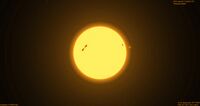Astronomy:HD 13189
| Observation data Equinox J2000.0]] (ICRS) | |
|---|---|
| Constellation | Triangulum |
| Right ascension | 02h 09m 40.1723s[1] |
| Declination | +32° 18′ 59.161″[1] |
| Apparent magnitude (V) | +7.57[2] |
| Characteristics | |
| Spectral type | K1II-III[3] |
| B−V color index | 1.465±0.016[4] |
| Astrometry | |
| Radial velocity (Rv) | 25.39[5] km/s |
| Proper motion (μ) | RA: 2.306±0.024[1] mas/yr Dec.: 4.935±0.022[1] mas/yr |
| Parallax (π) | 2.0450 ± 0.0240[1] mas |
| Distance | 1,590 ± 20 ly (489 ± 6 pc) |
| Absolute magnitude (MV) | −0.3[6] |
| Details | |
| Mass | 1.2[7] M☉ |
| Radius | 38[8] R☉ |
| Luminosity | 503[1] L☉ |
| Surface gravity (log g) | 1.21[7] cgs |
| Temperature | 4,035[7] K |
| Metallicity [Fe/H] | −0.18[7] dex |
| Age | 4.4[9] Gyr |
| Other designations | |
| Database references | |
| SIMBAD | data |
HD 13189 is a star with an orbiting companion in the northern constellation of Triangulum constellation. With an apparent visual magnitude of +7.57,[2] it is too faint to be visible to the normal human eye. The distance to this system is approximately 1,590 light years based on parallax measurements, and it is drifting further away with a radial velocity of 25.39 km/s.[5] In 2005, a planetary companion or brown dwarf was announced in orbit around this star.[2]
It has a spectral classification of K1II-III, making it a giant star that has evolved away from the main sequence after exhausting the hydrogen at its core. The mass is 1.2 times the Sun's, while measurements of the star's radius give estimates of 38 R☉. The atmosphere of the star displays short period radial velocity variations with a primary period of 4.89 days. This behavior is typical for giant K-type stars such as this and it is not the result of a close-orbit planetary companion.[11]
HD 13189 b
| Discovery | |
|---|---|
| Discovered by | Hatzes et al. |
| Discovery site | Tautenburg, Germany |
| Discovery date | 2005 |
| Radial Velocity | |
| Orbital characteristics | |
| 1.85 ± 0.35 AU (277,000,000 ± 52,000,000 km) | |
| Eccentricity | 0.28 ± 0.06 |
| Orbital period | 471.6 ± 6 d |
| astron|astron|helion}} | 2452327.9 ± 20.2 |
| 160.7 ± 12 | |
| Semi-amplitude | 6.8 ± 1.5 |
| Physical characteristics | |
| Mass | >14 ± 6 |♃|J}}}}}} |
HD 13189 b is an exoplanet or brown dwarf with mass ranges from 8 to 20 Jupiter mass. This object is located at a mean distance of 277 Gm (1.85 AU) from the star, taking 472 days to make one elliptical orbit.
This object was discovered in Tautenburg, Germany in 2005.[12]
References
- ↑ 1.0 1.1 1.2 1.3 1.4 Vallenari, A. et al. (2022). "Gaia Data Release 3. Summary of the content and survey properties". Astronomy & Astrophysics. doi:10.1051/0004-6361/202243940 Gaia DR3 record for this source at VizieR.
- ↑ 2.0 2.1 2.2 Hatzes, A. P. et al. (2005). "A giant planet around the massive giant star HD 13189". Astronomy and Astrophysics 437 (2): 743–751. doi:10.1051/0004-6361:20052850. Bibcode: 2005A&A...437..743H.
- ↑ Lee, B.-C. et al. (May 2011). "A likely exoplanet orbiting the oscillating K-giant α Arietis". Astronomy & Astrophysics 529: A134. doi:10.1051/0004-6361/201016293. Bibcode: 2011A&A...529A.134L.
- ↑ Anderson, E.; Francis, Ch. (2012). "XHIP: An extended hipparcos compilation". Astronomy Letters 38 (5): 331. doi:10.1134/S1063773712050015. Bibcode: 2012AstL...38..331A.
- ↑ 5.0 5.1 Famaey, B. et al. (January 2005). "Local kinematics of K and M giants from CORAVEL/Hipparcos/Tycho-2 data. Revisiting the concept of superclusters". Astronomy and Astrophysics 430 (1): 165–186. doi:10.1051/0004-6361:20041272. Bibcode: 2005A&A...430..165F.
- ↑ Gontcharov, G. A. (2011). "The red giant branch in the Tycho-2 catalogue". Astronomy Letters 37 (10): 707–717. doi:10.1134/S1063773711090040. Bibcode: 2011AstL...37..707G.
- ↑ 7.0 7.1 7.2 7.3 Anders, F. et al. (2022). "VizieR Online Data Catalog: StarHorse2, Gaia EDR3 photo-astrometric distances (Anders+, 2022)". Vizier Online Data Catalog. Bibcode: 2022yCat.1354....0A.
- ↑ Stassun, Keivan G.; Collins, Karen A.; Gaudi, B. Scott (2017). "Accurate Empirical Radii and Masses of Planets and Their Host Stars with Gaia Parallaxes". The Astronomical Journal 153 (3): 136. doi:10.3847/1538-3881/aa5df3. Bibcode: 2017AJ....153..136S.
- ↑ Maldonado, J.; Villaver, E. (2016). "Evolved stars and the origin of abundance trends in planet hosts". Astronomy and Astrophysics 588: A98. doi:10.1051/0004-6361/201527883. Bibcode: 2016A&A...588A..98M.
- ↑ "HD 13189 -- Star". SIMBAD. http://simbad.u-strasbg.fr/simbad/sim-id?Ident=HD+13189. Retrieved 2011-12-13.
- ↑ Hatzes, Artie P.; Zechmeister, Mathias (October 2008). "Stellar oscillations in planet-hosting giant stars". Journal of Physics: Conference Series 118 (1): 012016. doi:10.1088/1742-6596/118/1/012016. Bibcode: 2008JPhCS.118a2016H.
- ↑ A Giant Planet Around The Massive Giant Star HD 13189
External links
- "HD 13189 -- Star". SIMBAD. http://simbad.u-strasbg.fr/simbad/sim-id?protocol=html&Ident=HD+13189&NbIdent=1&Radius=2&Radius.unit=arcmin&submit=submit+id.
- "HD 13189 b -- Extra-solar Planet Candidate". SIMBAD. http://simbad.u-strasbg.fr/simbad/sim-id?Ident=HD+13189+b.
Coordinates: ![]() 02h 09m 40.1717s, +32° 18′ 59.1690″
02h 09m 40.1717s, +32° 18′ 59.1690″
 |


